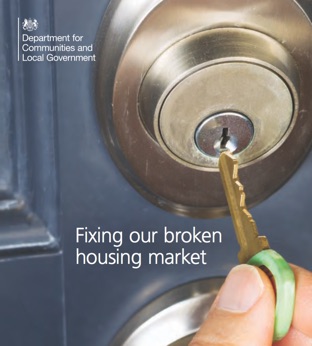Latest bPod® news
November 2017

London Mayor Sadiq Khan announces need for 860,000 new affordable homes
Interviewed on BBC Newsnight, Sadiq Khan said that “for too many years now, the few homes that have been deemed affordable aren’t really affordable.” He went on to say that London now needs 66,000 new homes a year in the next 20 years, and that 65% of these need to be affordable - “by how I define it rather than by the previous, dodgy definition.”
That’s nearly 43,000 affordable homes a year every year for 20 years! The Mayor ended the interview by saying “I can’t deliver that unless the government steps in and gives us the support we need.”
Back to Gallery Continue to Links
October 2017

Prime Minister takes personal charge of housing crisis
From Theresa May’s speech to the Conservative conference
“For 30 or 40 years we simply haven’t built enough homes. As a result, prices have risen so much that the average home now costs almost 8 times average earnings. And that’s been a disaster for young people in particular. We have begun to put this right….but the election result showed us that this is not nearly enough. We’ve listened and we’ve learned….and today, I can announce that we will invest an additional £2 billion in affordable housing…and in those parts of the country where the need is greatest, allow homes to be built for social rent, well below market level.
Getting government back into the business of building houses. A new generation of council houses to help fix our broken housing market. So whether you’re trying to buy your own home, renting privately and looking for more security, or have been waiting for years on a council list, help is on the way…as Prime Minister I am going to make it my mission to solve this problem. I will take personal charge of the government’s response…”
August 2017
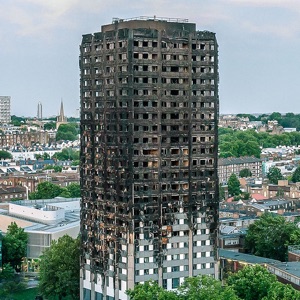
Open letter to Parliament: The great British housing hoax
Grenfell Tower
Months after the Grenfell Tower fire killed at least 80 people and made 120 families homeless, few survivors have been rehoused. The reason for this is the same that caused the fire in the first place: Britain lacks the affordable homes its people need for everyday use, so an emergency like Grenfell Tower can neither be prevented nor its aftermath properly dealt with.
The burnt-out hulk of Grenfell Tower now stands as a monument to decades of failed housing policies. Policies that have ignored the real problem, which is that too few homes are being built and what little is being built is too expensive.
The missing millions
Britain has for decades simply not built enough affordable homes to meet the needs of its growing population. Thatcher’s sale of social housing was meant to fund more building, but only half of this policy was ever implemented - the selling. The building never happened, and after four decades this has led to an affordable homes shortage of at least two million and growing. Or many times that if you count the vast number of substandard homes revealed by one survey after another.
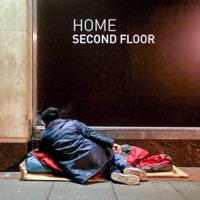
A generation betrayed
This self-inflicted housing crisis is of a size similar to the devastation Nazi Germany foisted upon the country, and the missing millions of homes are causing widespread misery. Many young people cannot find homes they can pay for, even if well educated or well employed, but are forced to live with parents or in shabby rent traps well past the age where they should have their own, prospering family homes.
Less privileged people are even worse off and are not helped by the blinkered notion that everyone must own their own little castle. An estimated 250,000 people a year are now affected by homelessness, from “sofa surfing” to sleeping on the street. The sum total of personal, social and economic cost is incalculable, but one expense that HAS been added up is the £600 million the NHS spends annually on health problems linked to housing issues.
Let them eat cake
Decades of government responses to this housing crisis have been much like Marie Antoinette’s to the French population’s cry for bread. People in Britain are offered “affordable” homes which are not only unaffordable, but untenable. The target of 40% affordable homes in any large development is heavily opposed by developers, often successfully circumvented - and even turned to profit by local government as in the case of Kensington and Chelsea.
Besides, the few homes that are built under this scheme are not truly affordable, but only conform to a phony definition of affordability made to suit the agendas of politicians and property speculators alike. Picture a world where the government demands of supermarkets that 40% of the food they offer must be affordable, but where supermarkets fight this tooth and nail and get away with selling only a tiny fraction of their food at prices people can actually pay. People would go hungry. And get angry.
Revolution or evolution?
You might think such an idea preposterous, but that is what we are allowing to happen with homes. The lack of food - people’s primary basic need - was at the root of the French revolution. Will the lack of people’s secondary basic need - shelter - lead to a British revolution, or will the powers that be realise in time that radical change is called for, and actually do something about it?
Modern methods of construction have been hailed as the solution to this crisis, but such methods have yet to make a meaningful dent in the housing shortage, and it now seems government support for developing truly innovative building technology is evaporating.
To make matters worse, Grenfell Tower shows the danger of letting building technology develop unchecked. What is needed are modern building methods that produce affordable homes without playing Russian roulette with people’s lives, and refurbishing half a century old tower blocks has now clearly been shown to meet none of those goals.
Buildpod
However, one such technology does exist. It is called Buildpod, or bPod for short, and was invented by a Danish architect a decade ago. bPod uses traditional, heavy building materials throughout, and is therefore as safe and non-flammable as concrete buildings have always been, before being adulterated with cheap, fancy materials.
At the same time bPod achieves savings on building costs of at least 30% and productivity gains of 50% or more, and of course meets or exceeds contemporary building and energy standards. This is done through offsite production and the use of modern methods, rather than with questionable materials. The 120 Grenfell Tower flats could have been built brand new with bPod technology for less than the £9 million cost of the fatally flawed refurbishment.
We could if only we would
This technology is now British owned and needs backing in order to be fully developed and approved, but the building industry has shown no interest in cutting costs or improving productivity. Why should they? They can sell all they can build at astronomical prices (more than £5,000 per square metre is now being touted as “affordable” in London). There is today neither the incentive nor the capacity to build the affordable homes Britain needs, and the drive to increase new construction with current technology is stretching the industry - and building standards - to breaking point while raising prices rather than reducing them.
In the early days of Theresa May’s premiership, government showed interest in bPod, but it seems things have now returned to business as usual. The DCLG recently told us that they “do not endorse particular technologies for building homes” and that “we do not currently have any further growth finance programmes for MMC [Modern Methods of Construction].” So much for “fixing our broken housing market” as the selfsame government promised in their white paper only six months ago - and so much for “a Britain that works for everyone.”
So while there is government support and funding for particular technologies in areas like energy, biotechnology, nanotechnology and many others, support appears to be disappearing - despite commitments to the contrary - for technology that would help deliver the millions of affordable, safe, modern quality homes that Britons need at least as urgently.
In a time of many uncertainties, such a housing policy could help people believe that Britain was starting to turn a corner.
July 2017
Millions live in unsafe homes
New figures from the English Housing Survey reveal that 525,000 social homes do not meet national Decent Homes Standard. 244,000 of these have “category one” safety hazards which expose occupants to fire and health risks.
This means that more than a million people in the UK live in social homes that fail the government’s own standards. Millions more live in private rentals that do the same.
We need to build millions of new, safe, affordable quality homes, and the only way to do that is by a fully industrialised offsite process that uses non-flammable materials throughout.
That’s exactly what bPod is.
Grenfell Tower cladding “like petrol”
Dr. Roth Phylaktou, a fire investigation expert at the University of Leeds, says that the Grenfell Tower cladding “would have burned as quickly as petrol.”
Why build homes out of flammable materials when non-flammable materials are available? Certainly not to economise. The 120 flats in Grenfell Tower could have been built new in bPod for less than the £9 million it cost to turn the old building into a torch.
Council made £50m from affordable housing deals
“The council that ran the Grenfell Tower block struck deals worth nearly £50m last year to allow developers to avoid having to build affordable homes," writes BBC News. In addition, “Kensington and Chelsea's own analysis shows it has built a fraction of the social housing the borough needs.”
No wonder the affordable homes we need are not being built, when home building relies on such failed incentives and fundamentally flawed policies.
The only way to build what we need is to change the way we build it. Fully industrialising home construction will make volumes go up and prices go down - like everything else we buy!
Why is that so hard to understand?
June 2017
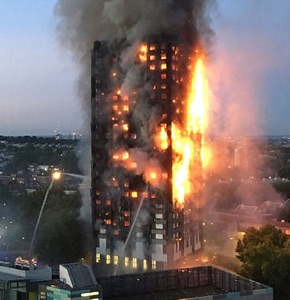
New-built nightmares and refurbished firetraps
With building defects sharply on the rise at one end of the scale and disasters like the Grenfell Tower fire at the other, “modern methods of construction” are getting a shoddy or downright dangerous reputation.
In contrast, the focus on safety sets apart responsible technologies like bPod®: safety of materials and methods; safety for the workforce and the occupants; safety built into the very fabric.
Inspired by the aviation industry, the bPod process has safety built into every procedure and component, which makes safety integral to the process and not an optional extra. We make cost savings through efficient work practices, not by cutting corners.
February 2017
⬅︎ Click on the image to download document
UK government publishes housing White Paper
The British government issues White Paper promising to “fix our broken housing market.”
Here are some notable quotes from the 104-page document:
Prime Minister Theresa May: “Our broken housing market is one of the greatest barriers to progress in Britain today… I want to fix this broken market so that housing is more affordable… The starting point is to build more homes… we will diversify the housing market, opening it up to smaller builders and those who embrace innovative and efficient methods.”
Communities Secretary Sajid Javid: “Over the years, the response from politicians has been piecemeal… That has to change… We need radical, lasting reform… seeking to build consensus for a new, positive, mindset to house building. A can-do approach that simply does not tolerate failure.”
The White Paper’s conclusions support bPod’s long-held position that we need to fundamentally change the way we build, that offsite building is the key to building more, and that it must start to happen NOW.
September 2014
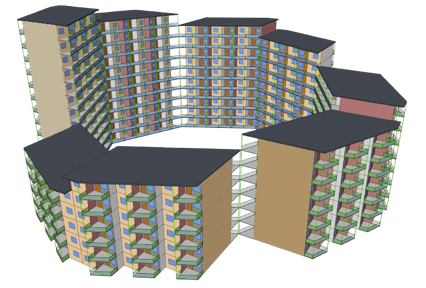
bPod® introduces buildAbillionHomes
buildAbillionHomes is a concept which optimises the already frugal bPod building system for even more efficient mass production. This is aimed at supplying hundreds of millions of affordable quality homes world wide, especially in China and South East Asia.
buildAbillionHomes combines a flexible design with the proven economic and quality benefits of industrial mass production to meet those needs.
This brings to the building industry the large scale application of fully industrialised manufacturing which has never been done before.
The basic buildAbillionHomes unit provides a living space of just under 30 m². More room is achieved by connecting two or more units on a modular grid, resulting in home sizes of approximately 40 m², 50 m², 60 m², 70 m² and so on.
Simply put, this is “Live-In Lego” with all the benefits that mass production brings. With buildAbillionHomes, bPod aims to push savings on building cost beyond 30%, to 50% or more. That was done with cars, TVs, fridges, computers and everything else we buy. Now it will be done with homes.
Industrial production means that the more standardised the product, the more efficient the use of facilities and manpower and the greater the savings. But crucially, that does not have to lead to drab and dreary concrete deserts, as shown in this light and airy buildAbillionHomes design by bPod architect Ole Bjerre.
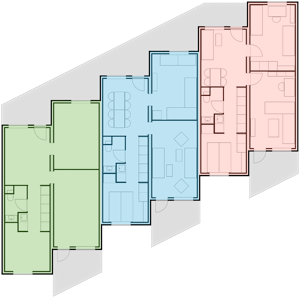
March 2014
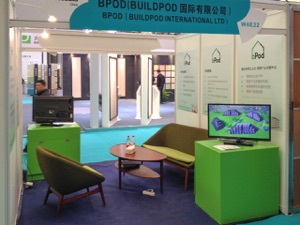
bPod® on Ecobuild China
bPod participates in the Ecobuild China exhibition in Shanghai New International Expo Centre from 31st March to 3rd April:
Ecobuild China is the region's meeting place for the sustainable built environment industry and we look forward to welcoming you on stand W4E22.
October 2013
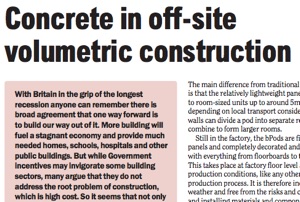
bPod® featured in Concrete Magazine
The October issue of concrete, the global magazine of The Concrete Society, shows bPod introducing concrete to off-site volumetric construction. Traditional off-site methods use light materials with attendant limitations on buildings and structures. In contrast, a bPod building, once assembled, has the same well-known strengths of a building made in traditional, heavy construction.
And then it has one added benefit: it’s cheaper to build. With large parts of the world in the grip of a recession, off-site contruction offers a way to lower construction costs that no subsidy scheme can achieve - without creating bubbles along the way.
Read the article here.
May 2013
bPod® test build in progress
bPod Denmark has established the first bPod build in the shape of a “test bench” which will be used to develop and optimise the bPod concept alongside planned customer deliveries.
The test bench is situated at the bPod Denmark production facility at Herlufmagle. First deliveries are scheduled for late 2013, and the test bench is also intended to give interested developers a chance to inspect the bPod product.



March 2013
bPod® shows a way to build the affordable homes people need
Savings on construction is better than subsidies at helping people find a home
In the UK, the Chancellor of the Exchequer introduced a mortgage guarantee scheme in his 2013 budget. He aims to create 570,000 new homes over three years and help first time buyers get on the housing ladder.
However, commentators say subsidies will only inflate property prices and much of the stimulus will be wasted on remortgaging or second homes. Many believe that government handouts do nothing to address the root problem which is one of high construction costs.
High building costs result in expensive developments which are out of reach of most first time buyers, and observers call for a new vision to address the housing crisis of today.
Such a vision does exist and is based on the simple fact that all other areas of industry have seen prices drop and quality improve through efficient manufacturing methods. Everything from cars to TVs, and even food, but not what matters most - our homes.
That is precisely what bPod sets out to change. With industrialised building methods achieving savings of up to a third of construction costs, the bPod vision means building half as much again with the same money and manpower.
This will genuinely help people on ordinary incomes find a home.
March 2012
Latest research supports ideas behind bPod® building method and business model
Recent research at the Robert Gordon University, Aberdeen into the barriers to transforming the building industry comes to the conclusion that the building trade has reached the limits of its potential because it has never been fully industrialised as have other areas of production.
This adds scientific gravitas to the fundamental ideas behind the bPod production method and business model which are expressed as follows in the introduction to the bPod website:
“Building practices have changed little for decades and will benefit from the introduction of modern production methods. The patented bPod building technology and its innovative business model do just that.”
February 2012
bPod® launched in Scandinavia through Nordic franchise and sales organisation
Danish/Swiss entrepreneur Anders Kähler is awarded a master franchise for bPod in Sweden, Norway, Finland and Denmark. Kähler thereby continues his family’s 150-year tradition of innovation and product development in the building industry and is set to move multi storey construction into the 21st century.
Sub-franchises will be established in each country, the first one being bPod Danmark. Production start is planned for 2012 and other Nordic countries follow as soon as practicable.
At the same time, Kähler has signed a sales agreement with Danish estate agents Colliers International Danmark. With sales offices throughout the four countries, Colliers are uniquely placed to give the bPod system the best possible Scandinavian market exposure.
The use of licensing, franchising and sales agreements demonstrates the modernising bPod is planning for the building industry. We believe this will ensure a much wider and faster implementation than if the system were tied to traditional in-house production in a local market.
August 2011
bPod® presents draft project meeting 2015 low energy standards to leading Danish housing association KAB
Energy standards in Danish residential building has gone from 70 kWh per square metre per year in 2008 to 53 kWh in the 2010 building regulations to an expected 30 kWh by 2015. Traditionally insulated multi-storey buildings can only just meet 53 kWh and it will be difficult to reduce this further due to structural constraints on the amount and type of outer wall insulation.
Outer walls in bPod construction have no limitations on the amount or type of insulation, and the latest bPod draft project for KAB, one of Denmark’s largest housing associations, shows additional building costs of less than 5% to insulate a 5-storey, 2,000 square metre residential building to 2015 standards. Such a building would still be 25% cheaper than a conventional construction built to 2010 standards.
No deductions are made for sustainable energy sources in these numbers, and wind turbines, solar panels or heat pumps can therefore further reduce the amount of conventional energy used.
May 2011
Building of social housing in Denmark is at an all-time low despite last year’s record level grants and long waiting lists. In Copenhagen alone, more than 100,000 people, and rising, are wait-listed.
The reason is building costs now exceeding the cost cap introduced by the Danish government to prevent social housing rents rising “higher than ordinary people can afford”.
bPod® offers a way out of this conundrum. With savings up to 30% compared to conventional construction, new builds can be completed within the cost cap. This is achieved through modernisation of the building process, partly by moving it largely indoors, partly through reducing waste and faults.
For some years, wooden cassettes have been used for much new construction. These are maintenance intensive and can be expected to have a relatively short life span, but even so they are now breaking the cost cap. In contrast, bPod uses durable, heavy materials like concrete in ways which combine modern energy and environmental concerns with quality of living, low maintenance and long life.
April 2011

In contrast, all bPod® buildings are fitted with high efficiency mechanical ventilation to all rooms (not just kitchens and bathrooms). This prevents mould formation and also reduces energy consumption. Mechanical ventilation with high heat recovery saves significant energy compared to “natural ventilation” where fresh air from outside has to be heated to room temperature.
February 2011

In contrast, bPod® buildings are constructed with a reinforced concrete framework which can be designed to withstand considerable earthquake forces. Even if a bPod building is damaged by an earthquake, possibly beyond repair, it will remain standing rather than collapse on its occupants.
This safety and strength is achieved without sacrificing the cost and time savings that bPod construction offers over traditional building, making it an ideal method for new construction in earthquake zones as well as rebuilding after earthquake disasters.
November 2010
The construction industry is one of the most dangerous and unhealthy for its employees, and Danish press recently reported 105 out of 195 building sites being shut down by Health and Safety due to serious breaches in many cases putting workers in direct danger of their lives.
In stark contrast to this traditional image of building, the bPod® system removes the risks and strains associated with working at great heights, outdoors and in all weather. By performing most of the construction work indoors and at ground level, heavy and damaging work is taken over by machines, and workers need rarely leave the safety of solid ground. Safety throughout the building process is not optional but is achieved and maintained through systems and methods built into the bPod technology from the start.
The patented bPod building technology not only offers financial savings of up to 30% on traditional building costs, but provides significant benefits for its workers, the environment and those who will eventually live in the buildings.
October 2010
Unlike most multi-storey construction, the bPod® technology favours underfloor heating for its greater thermal efficiency and better suitability to sustainable energy sources.
A report presented this month to the Nordic Passive House conference now shows the benefits of using the same underfloor pipes to lower floor temperatures in summer, acting as an energy efficient cooling system.
September 2010
Recycled paper insulation is offered as yet another alternative to mineral fibre in bPod® construction. Paper insulation uses less energy in its manufacture, further enhancing the green profile of bPod® buildings.
With bPod, multistorey buildings are for the first time able to meet low energy standards, due to the unique ability of bPod to construct wall cavities of any dimension and use a variety of insulation types.
August 2010
Use of the space age superinsulation material aerogel is being developed by bPod® as an alternative insulation material.
Aerogel insulates two to three times better than mineral fibres and therefore allows much thinner walls than would otherwise be possible in low energy buildings. This solves problems associated with reduced daylight and floor space in low energy construction.
Although aerogel is up to 50 times more expensive than standard insulation, bPod’s unique construction method retains much of its cost saving, and a bPod building using aerogel insulation is still cheaper to build than a standard insulated building in traditional construction.
March 2010
The patented bPod® technology is currently under development. When fully developed, the system will be licensed or franchised to building manufacturers and developers worldwide.
Interested parties can register with us now in order to receive progress reports and place themselves in pole position in their own market.
Although the building industry is hit by the present recession, we see this as the right time to develop new technology in readiness for an upturn. When that comes, the need to build economically and environmentally sound will be greater than ever, and bPod will be perfectly placed to meet that need.



bPod, build pod, build-pod, pod build, build, building, building technology, construction, volumetric, offsite, multi-storey, low-rise, lo-rise, medium rise, apartment, hotel, youth hostel, office, concrete, energy efficient, green, new way, superinsulation, aerogel, nanogel
Gestalt, Gebäude, Bautechnologie, Bau, mehrstöckig, Hochhaus, Wohnung, Hotel, Jugend-Herberge, Büro, Beton, Energiesparende, grüne, neue Methode
construction, bâtiment, technologie de la construction, construction, à plusieurs étages, en hauteur, appartement, hôtel, auberge de jeunesse, bureau, béton, performance énergétique, vert, nouvelle méthode, isolation maximum, aérogel, nanogel
byggeri, konstruktion, etagebyggeri, lejlighed, hotel, kollegie, kontor, beton, energi, energibesparelse, grøn, ny metode, superisolering
